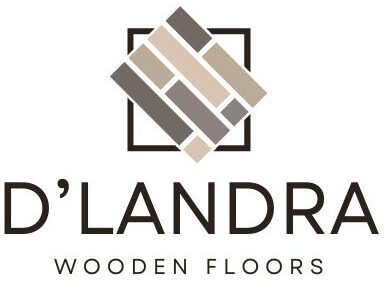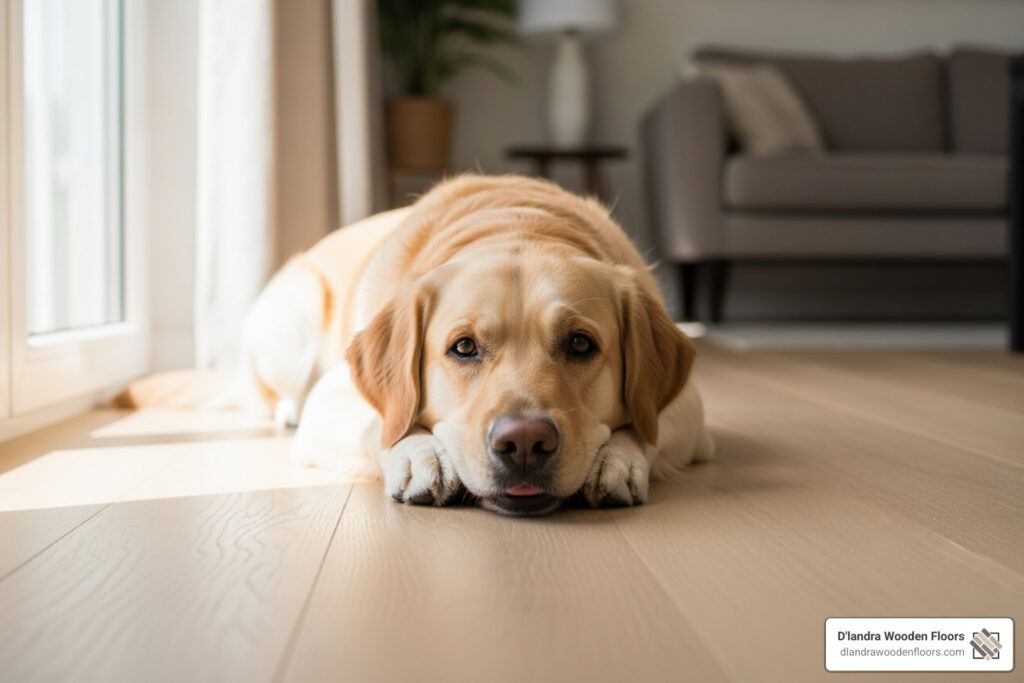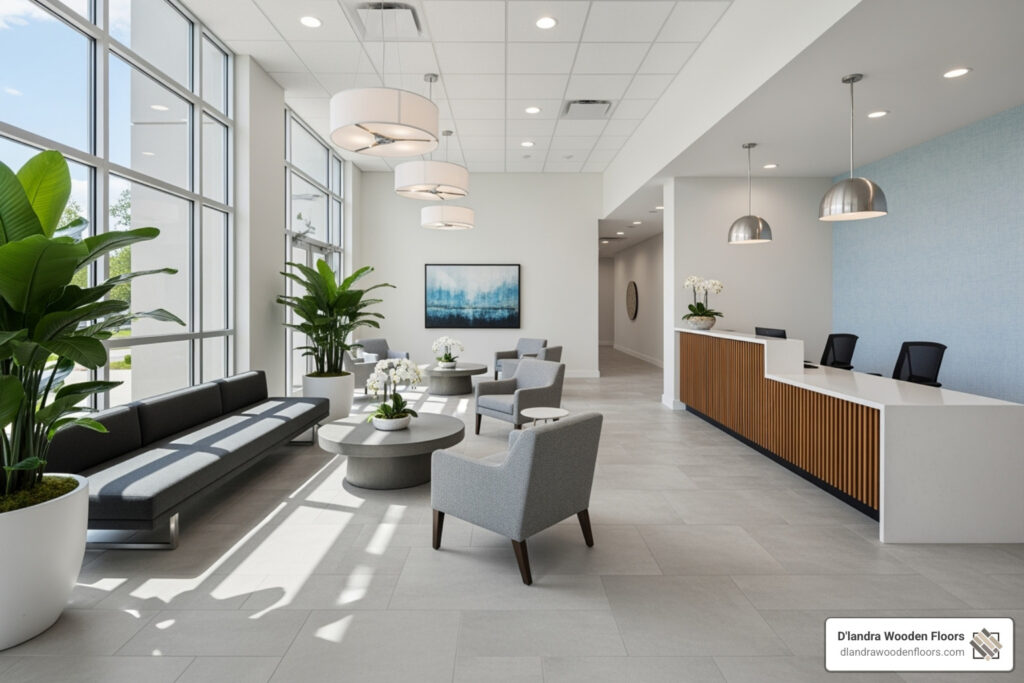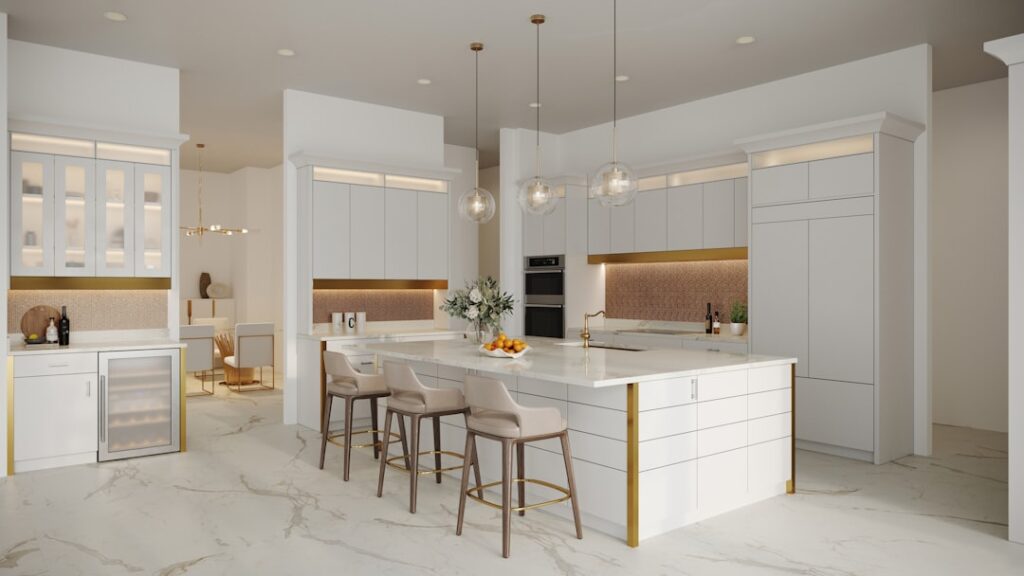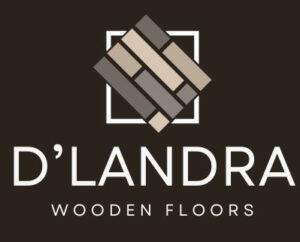In South Florida, the humidity and changing temperatures can be tough on floors. That’s why many homeowners pick engineered hardwood. It’s made with layers that stand strong against moisture. These layers include a real wood surface on top of multiple core layers. This design helps prevent common problems like cupping, warping, and splitting that solid wood floors face in humid places.
Engineered hardwood has a top layer of real hardwood. It’s attached to a base of plywood or high-density fiberboard (HDF). On the other hand, solid wood floors come from a single piece of wood. These differences affect how well floors perform in South Florida homes, especially those near the ocean, outdoor lounging areas, and directly on concrete.
We’ll guide you through everything you need to know about these floors. We’ll discuss durability, how they’re installed, costs, style, taking care of them, where to buy, and how to work with installers. With this info, you’ll be able to choose whether engineered wood or solid wood is best for your home.
Table of Contents
ToggleKey Takeaways
- Engineered hardwood offers greater resistance to humidity-driven movement than solid wood.
- Its construction—with a plywood or HDF core and a hardwood veneer—gives engineered flooring its stability.
- Pick hardwood flooring products in South Florida meant for coastal areas and concrete floors.
- There’s a difference in how you install, maintain, and get value from engineered wood flooring versus solid wood.
- This guide explains durability, looks, costs, and finding trustworthy suppliers and installers.
Overview: Engineered Hardwood vs Solid Wood for South Florida Homes
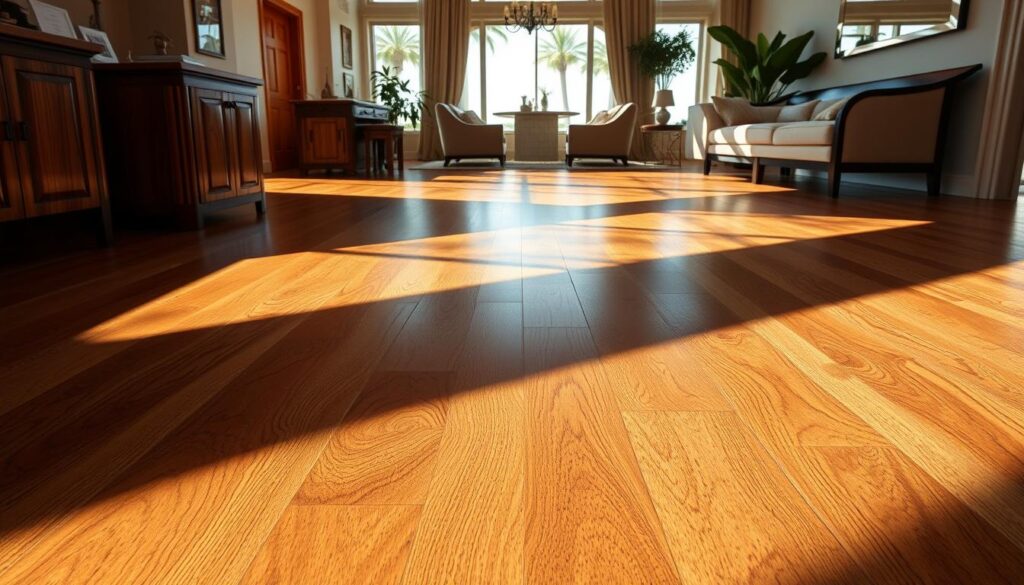
If you live in South Florida, it’s important to understand how engineered and solid wood floors handle the climate. This guide compares their structures, how they react to the climate, and what local homeowners prefer.
Quick comparison of materials and construction
- Engineered: a wear layer of 2–6 mm of real hardwood over a plywood or HDF core with glued cross‑layers for dimensional stability. Typical plank widths run from 3″ to 7″. Finishes include UV-cured aluminum oxide, oil, and lacquer.
- Solid: a single 3/4″ plank carved from one wood species, generally in 2 1/4″ to 5″ widths. It can be repeatedly sanded and refinished, but moisture impacts the entire board.
How climate and humidity impact flooring choices
In South Florida, the humidity is often above 60%, with tropical storms and salty air common. These conditions can increase indoor moisture levels, affecting wood floors.
Solid wood may swell, cup, or create gaps from moisture changes. On the other hand, engineered wood floors are designed to better handle these changes. Their cross-laminated cores help resist movement.
What South Florida homeowners value in flooring
- Durability against humidity, without needing many repairs.
- Easy care that suits a fast-paced life.
- Cost-effective options with a high resale value and authentic appearance.
- Works well with air conditioning and looks seamless next to tile in coastal houses.
When deciding, many find engineered hardwood in South Florida a smart choice. It offers the beauty of wood without as much risk from the climate.
Why Durability Matters in South Florida Flooring
Your flooring must stand up to high humidity, frequent storms, sun rays, and salty air. Picking the right product now can prevent future issues like cupping, gapping, and expensive repairs. Engineered floors tend to perform better in these conditions due to their multi-layer construction.
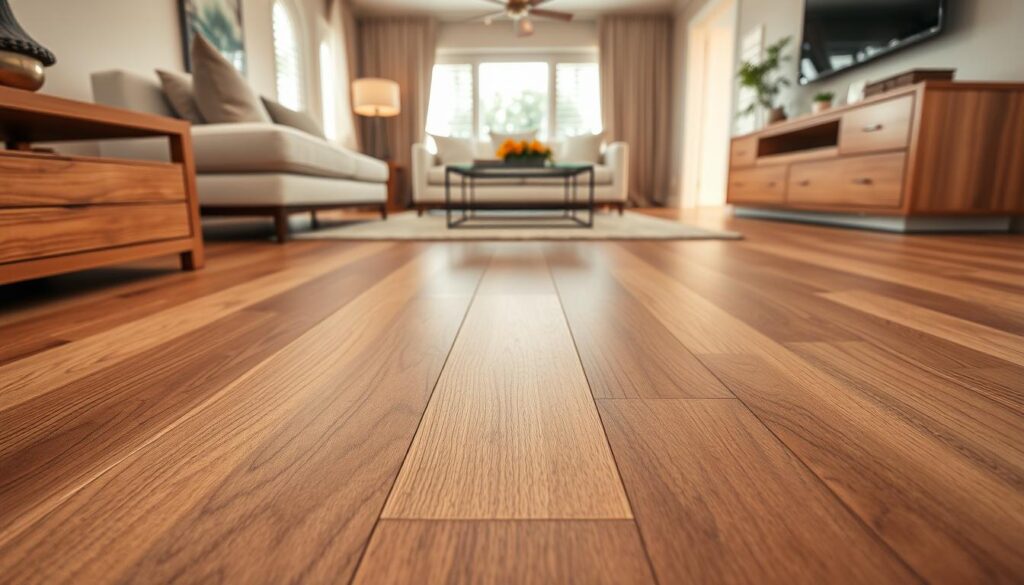
Moisture resistance differences between engineered and solid wood
In South Florida, buyers prefer engineered hardwood with plywood or HDF cores. These cores have grains that go in opposite directions. This design lessens movement when moisture levels change. Some engineered types can even be used over concrete slabs or in lower-than-ground locations. This is vital in areas that are close to the coast or likely to flood.
Solid wood expands and contracts more because of its structure, which makes it a poor choice for places with a lot of moisture. If your home sits directly on the ground or has concrete underneath, you should pick engineered options that handle moisture well.
Wear layer performance and scratch resistance
The durability of a floor against scratches and everyday use depends on its top layer and finish. It’s smart to look at the thickness of the wear layer and how hard the wood is. White oak and European oak are popular for floors in South Florida. They have good Janka scores but aren’t too pricey.
Finishes that are cured with UV light or contain aluminum oxide help resist scratches better and make upkeep easier. A thicker wear layer means you can sand and refinish the floor later on. For top-notch floors in South Florida, go for a thicker veneer with an aluminum-oxide or UV-cured coating to ensure it lasts a long time.
Long-term stability in coastal environments
Coastal homes deal with salty air that can damage fasteners and metal edges. Using screws that don’t rust and trims that are stainless steel or coated can protect these parts. Coatings that resist UV light help keep the floor’s color from fading due to the strong sun.
Engineered floors maintain their shape and remain stable over the years, even with changes in humidity and temperature. Their cross-ply core is less likely to warp than solid wood is. This stability means fewer repairs and helps your floor stay in good condition in the challenging South Florida weather.
engineered hardwood South Florida
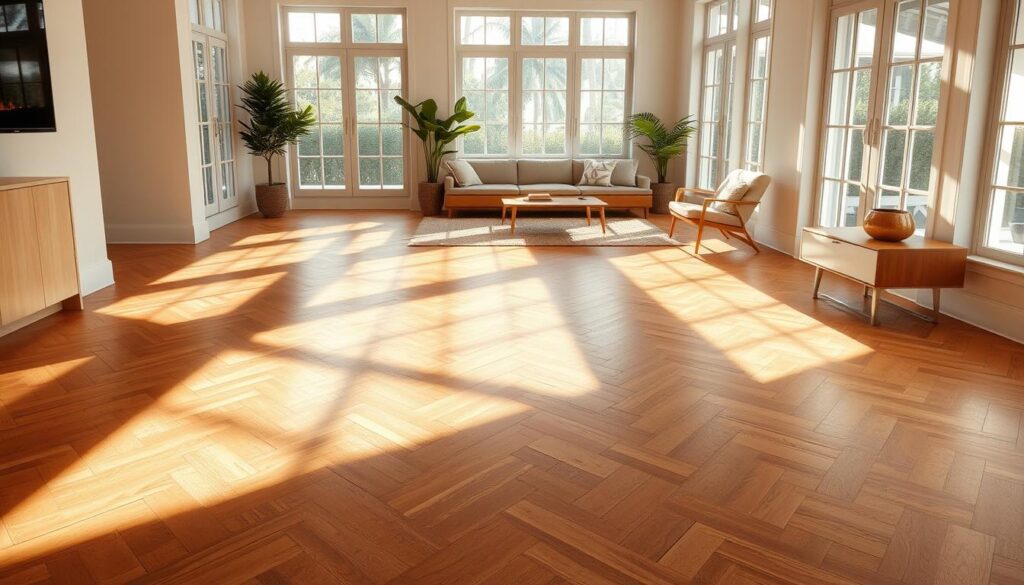
Engineered hardwood is often recommended from Miami to West Palm Beach. It’s popular for condos, homes on concrete, and coastal properties. It works well with glue-down or floating installations, reducing install time. This also minimizes the chance of cupping, which can affect warranties.
Buying engineered hardwood in South Florida means a quicker acclimation than solid planks. This is important for fast remodels or resales. Contractors like its stability during AC use and sudden humidity changes, which can stress solid wood.
Why this product type is commonly recommended in the region
Experts in Fort Lauderdale and Miami pick engineered floors for their resistance to expansion and contraction. Its layered build keeps boards flat on concrete and limits movement by doors.
Thicker veneers, about 3–6 mm, make it durable and allow for some sanding. This offers repair options. Select warranties based on installation methods protect your investment against moisture spikes.
Popular species and finishes available locally
Shops in South Florida offer a wide selection, including white oak, red oak, and maple. Brazilian cherry is a top choice for luxury homes.
There’s a trend toward wire-brushed and hand-scraped finishes. You’ll find matte UV-cured polyurethane, aluminum-oxide for scratch resistance, and oil finishes for a natural look. Popular colors include warm neutrals to gray tones for coastal styles.
How engineered construction combats humidity and temperature swings
Engineered hardwood’s layering reduces the risk of cupping or gapping when it’s humid. AC cycles causing rapid temperature changes are less of an issue with engineered cores, keeping floors stable.
If you’re watching your budget, there are affordable options in South Florida. Lower-cost choices might have thinner wear layers but still perform well over concrete. Consider veneer thickness and long-term needs to ensure good value.
Engineered hardwood in South Florida offers various species, finishes, and durable construction for the climate. Whether for a condo or a coastal home, it combines looks, performance, and value.
Installation Considerations: Engineered Wood Flooring vs Solid Wood
When you pick engineered wood flooring or solid wood, your project’s path is shaped. The choice affects how you install, prepare the subfloor, and handle moisture. This impacts the timeline, costs, and any warranty risks. Familiarize yourself with the key points below. It will help you plan with local experts and avoid any surprises.
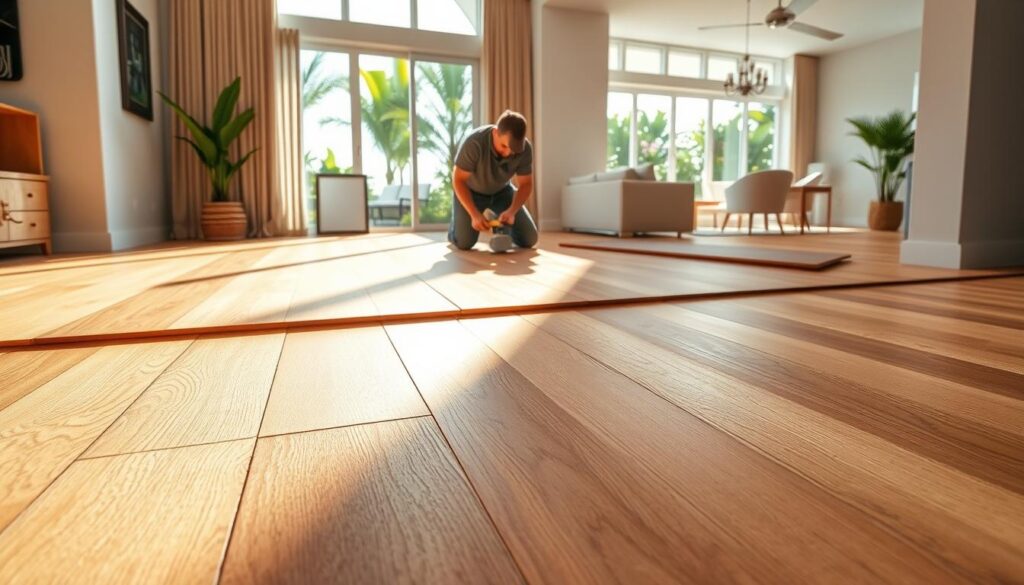
Floating, glue-down, and nail-down methods
- Floating floors are quick and simple. They’re great over plywood or concrete with a vapor barrier. This choice means fast setup and easy fixes, making it a favorite for engineered hardwood in South Florida.
- For concrete slabs, glue-down is advisable. Pick adhesives suited for high moisture. Low-VOC options are better for engineered wood flooring in South Florida.
- Use nail- or staple-down for upper-level wood subfloors. This traditional approach needs certain plywood or OSB and skilled workers.
Subfloor and moisture barrier needs
- Test for moisture using calcium chloride for slabs or RH probes for concrete. Stay within the makers’ moisture limits to avoid warranty issues.
- A 6-mil poly sheet should go under floating floors on concrete. If moisture’s high, consider epoxy solutions or special primers.
- Pick adhesives that can handle damp areas for glue-down floors. Right moisture management and product choice are key for warranty and air quality.
Differences in time, disruption, and cost
- Floating installs are fastest. They have short cure times, so you can move furniture back sooner. Glue-down methods take longer due to adhesives drying, which means more disruption.
- Glue-down and nail-down jobs usually cost more in labor. Prices for materials vary by type and finish. Choosing engineered hardwood in South Florida often saves both time and money, especially in coastal areas.
- Engineered planks adapt quicker than solid wood. Make sure your HVAC and dehumidifiers are ready before starting. This prevents gaps and other issues.
Cost and Value: Affordable Engineered Hardwood South Florida Options
Finding the right flooring is about mixing style, durability, and cost. You’re looking for a floor that can handle humidity and salt air and not break the bank. Affordable engineered hardwood in South Florida is a good option for many. It balances price and quality well.
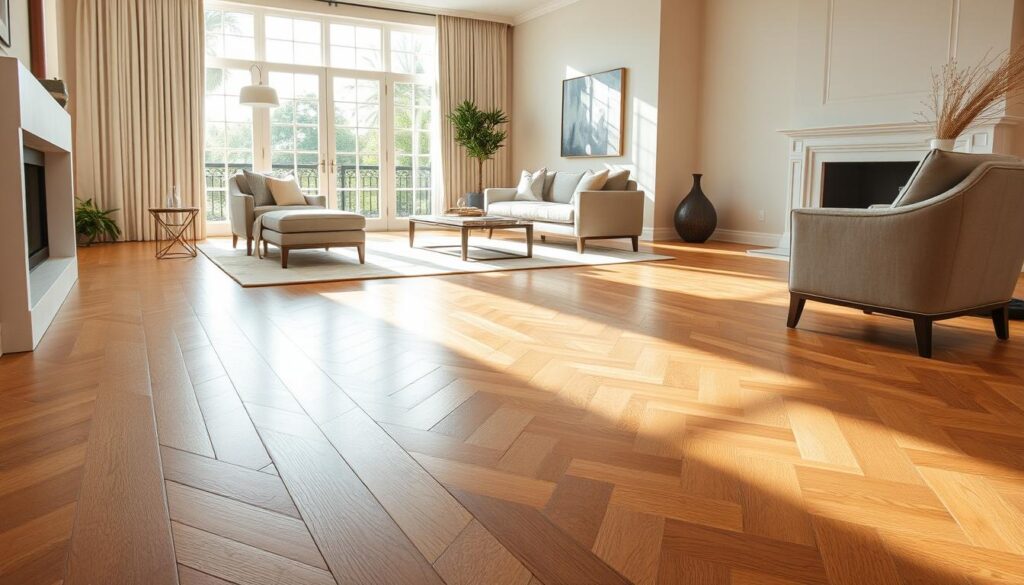
Upfront pricing compared to solid wood
Starting prices for engineered planks are often lower than $3 to $5 per square foot for just the materials. The total cost with installation for basic options is usually between $5 and $9 per square foot. However, solid hardwood starts at about $8 per square foot installed and goes up from there.
Premium engineered floors with thicker wear layers and wider planks can get pricier, about $10 to $15 per square foot installed.
Maintenance and lifecycle cost analysis
Engineered hardwood reduces long-term repair costs for coastal homes. It’s less likely you’ll spend on moisture-related fixes. Choosing floors with thicker veneers means spending less on cleaning and occasional refinishing or recoating.
Top brands like Shaw, Mohawk, and Armstrong often offer 25 years to lifetime warranties. These warranties help lower the total cost over time.
How to get the best value when you buy engineered hardwood in south florida
- Get quotes from at least three licensed installers to compare costs.
- Pick well-known brands available at local showrooms in Miami, Fort Lauderdale, or West Palm Beach to check out samples.
- Search for engineered options with 3–6 mm wear layers and either plywood or HDF cores, based on your needs.
- Look out for promotions and make sure the warranty can be transferred if you sell your home.
Keep in mind both the cost of materials and installation. The finest engineered hardwood in South Florida offers fair prices, solid warranties, and is moisture-resistant. When buying, think about the total installed cost, wear layer thickness, and the experience of local installers. This approach will give you the best value over time.
Style and Aesthetics: Matching Your South Florida Home Design
When choosing flooring for your South Florida home, think about both design and coastal needs. Pick colors, textures, and widths that make your rooms feel great under bright sunlight and salty air. This way, whether you have a chic Miami loft or a cozy Palm Beach cottage, it will still look right and last long.
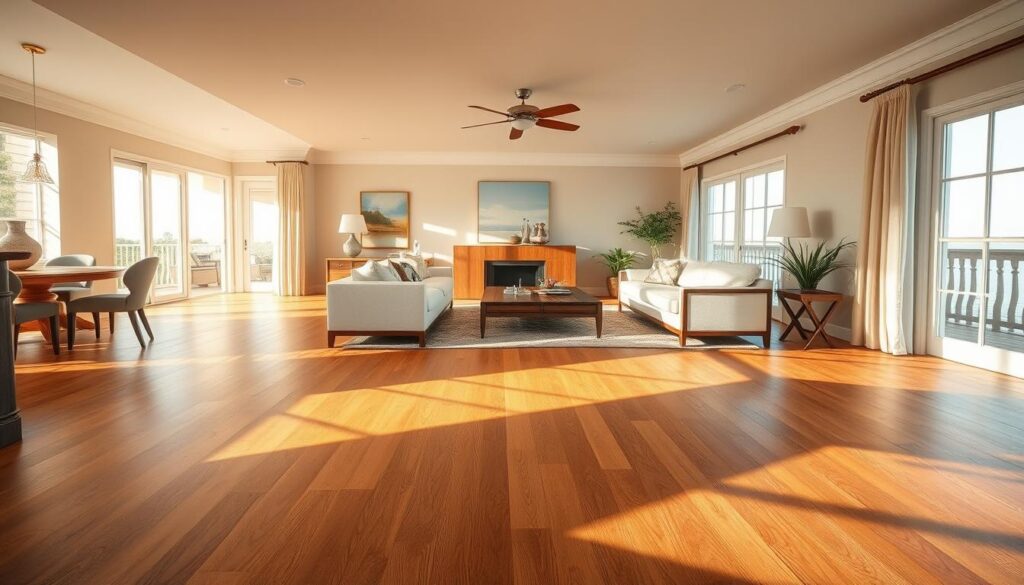
Trends in colors, textures, and plank widths
Now, wide-plank boards that are 5″–8″ or wider are in style here. They make spaces look bigger and fit well in open condos and homes. Textures like wire-brushed and hand-scraped hide wear and match the relaxed coastal vibe.
People love light blonde, warm sand, and weathered gray colors. In Miami, styles mix modern and classic, while Palm Beach homes lean more traditional. When looking for hardwood flooring in South Florida, try out samples at home to see them in natural light.
Visual differences between engineered and solid hardwood
Engineered hardwood in South Florida looks almost the same as solid wood. What makes them different are things like grain, type of wood, width, and finish.
If you worry about scratches showing, choose engineered hardwood with thicker layers. This is especially true for busy areas where you might want to sand and refinish later. Well-known brands offer high-quality engineered hardwood that closely matches solid wood’s appearance.
Choosing finishes that hold up to sunlight and coastal living
Finishes that resist UV light can help prevent fading. Light colors don’t show sun damage as much as dark ones. Stay away from very dark finishes in rooms that get a lot of sunlight to avoid UV bleaching and excess heat.
In sunny spots, throw down some area rugs and maybe add UV-blocking window film. For floors that stay beautiful and durable, always ask about the finish warranty. This is a smart move whether you’re buying engineered or top-rated engineered hardwood in South Florida.
Maintenance and Care for Hardwood Flooring South Florida
Keeping your floors looking new in South Florida’s humid climate takes care. Follow easy daily and seasonal routines. These steps protect both engineered and solid wood floors from humidity, salt, and everyday wear.
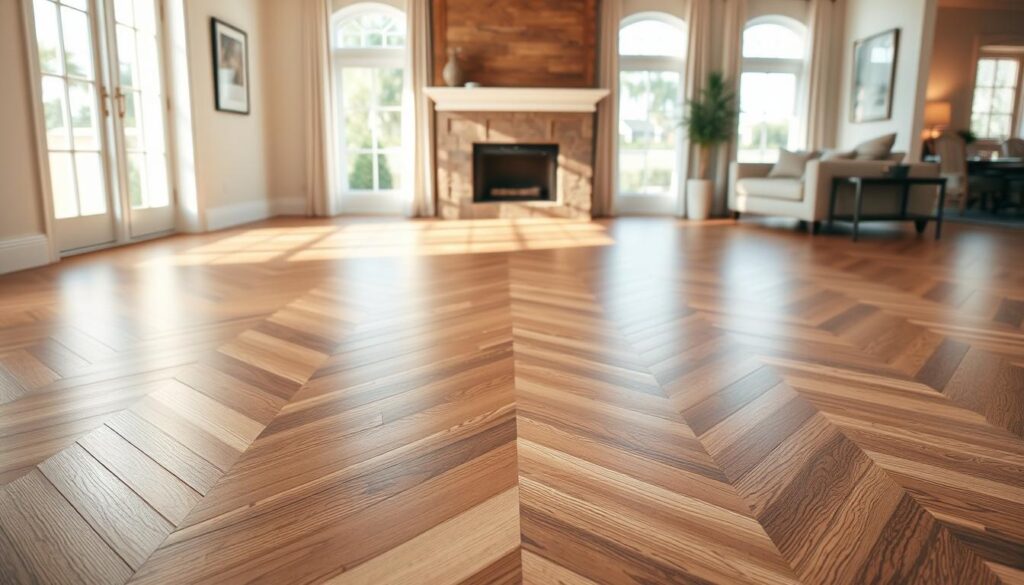
Daily and seasonal care
- Sweep or use a soft brush vacuum daily to avoid scratches from dirt.
- Clean lightly with a microfiber mop and pH-neutral cleaner. Avoid steam mops and soaking floors.
- Always clean up spills right away to stop stains and warping.
- Keep indoor humidity between 40–55% using A/C and dehumidifiers. Check for floor damage after storms, adjusting humidity as needed.
Refinishing and repair options
- Engineered hardwood in South Florida that has a 3 mm or thicker veneer can be sanded and refinished a few times. Floors with thinner veneers need board replacements or repairs for severe damage.
- Solid wood floors can be sanded and refinished several times, making them easier to fix after heavy use.
- Fixes include replacing boards, localized sanding, and using kits for minor surface issues.
Preventative measures for coastal exposures
- Use doormats at every door and wash off salt from shoes and entrances after visiting the beach.
- Put felt pads under furniture and protect metal from corrosion.
- Check regularly for pests. Termites typically attack the subfloor more than the hardwood, so inspect crawl spaces and edges.
- Stick to the manufacturer’s care guide to keep your warranty valid for your flooring.
Regular care keeps your hardwood floors safe from expensive repairs and looking good. Taking small steps each season ensures long-lasting protection and beauty for your floors.
Finding the Best Engineered Hardwood in South Florida
Choosing the right engineered hardwood is more than picking a sample you like. Consider the thickness of the wear layer, type of finish, authenticity of the wood species, and how well it’s made. Look into the warranty and get feedback from local installers before making a decision.
- Read reviews on Houzz, Angi, and Google Reviews to spot consistent praise or complaints.
- Pay attention to how well the products withstand long-term use and South Florida’s humid climate.
- Compare showroom samples with photos of installed floors to check the realism of species appearance and finish.
Questions to ask suppliers and showrooms:
- Ask about the thickness of the wear layer and if you can see a cross-section.
- Inquire about the best installation methods for homes in South Florida, like floating, glue-down, or nail-down.
- Learn about their procedures for acclimatization and moisture testing on site.
- Find out which adhesives and underlayments are recommended for use in coastal areas.
- Ask about typical waiting times and the cost of delivery from suppliers of engineered hardwood in South Florida.
- Request references for local installers who have completed similar projects.
Verification of warranties and certifications:
- Make sure to get residential wear warranties, structural warranties, and finish warranties in writing.
- Search for certifications like FloorScore, FSC, and CARB to ensure the product is safe and sustainable.
- Read the warranty’s fine print carefully, especially regarding environmental damage like moisture, and understand how claims are managed.
When looking for the best-engineered hardwood in South Florida, keep notes and compare options carefully. Rely on detailed reviews and the responses you get from suppliers. This helps you find top-rated engineered hardwood in South Florida that fits both your home and your budget.
Working with Local Professionals: Installation and Suppliers
When you’re planning a flooring project in South Florida, it’s key to work with local pros. The right team will protect your money, prevent delays, and make sure everything is up to local building and humidity standards.
Choosing installers
- Choose installers who are licensed and insured, have a South Florida portfolio, and can offer client references.
- Look for installers with certifications from brands like Shaw, Mohawk, Armstrong, or Bona for quality assurance.
- Insist on a detailed plan that includes checks for moisture, how the floor will be prepped, and warranty info before starting.
- Make sure they have liability insurance and worker’s compensation to protect yourself from accident-related costs.
Supplier and sourcing considerations
- Visit showrooms to see and feel samples under natural light before deciding on engineered hardwood.
- Pick dealers with local warehouses to speed up delivery and ensure reliable service.
- Explore a variety of choices, including national brands and European ones found in South Florida.
- Plan for possible shipping delays, especially during busy seasons or with custom orders. Talk to your supplier early on.
Project timelines and permitting
- Initial site reviews and taking measurements may needs one to two days.
- Waiting for materials can take anywhere from one to six weeks, depending on availability and customization.
- Installing the flooring can last from one to seven days, depending on the area size and installation method.
- Give the new floor time to settle and the finish to cure before heavy use.
- While most flooring jobs inside won’t need permits, condos or historic areas might. Always check early.
- Plan your flooring work around HVAC installations or other remodels to keep indoor humidity levels stable.
Working with trusted teams and buying from credible sources make for a smoother project. For certified installers and reliable suppliers, ask your showroom to recommend some. This way, you can confidently buy engineered hardwood in South Florida and get it installed on time and professionally.
Eco‑friendly and Health Considerations for Your Flooring Choice
You want your floor to look amazing and be healthy for your home. The choice between engineered hardwood and solid wood impacts sustainability, air quality, and disposal. This guide makes comparing those options simpler and encourages looking at certifications for confidence.
Sustainability differences
Engineered hardwood uses a thin top layer of real wood over a core of plywood or HDF. This method needs less of the slow-growing timber than solid planks do. Choose products with cores from quickly renewable resources or recycled wood fibers to help mature forests.
When shopping for hardwood flooring south florida, look for the FSC or PEFC labels. They mean the wood comes from forests that are cared for responsibly. Solid wood might be okay if it has these certifications, but it usually requires more wood to make.
Indoor air quality and VOCs
What finishes and glues are used is key for air quality at home. Many of these products send out VOCs soon after being laid. This can bother those with sensitivities and change the air quality in your space.
Opt for products certified with FloorScore or Greenguard and use adhesives that are within CARB Phase 2 standards. Get the data sheets from sellers to check VOC levels for engineered hardwood south florida and more.
Recycling, end‑of‑life options, and certifications to seek
- Engineered floors are hard to recycle due to the multiple layers and glues.
- They can be broken down into chips or composite materials if facilities nearby allow it.
- Giving them to places like Habitat for Humanity ReStores or local salvage shops can prolong their usage.
Look for FSC or PEFC, FloorScore, or Greenguard certifications when examining products. Also, find out what the manufacturers say about the chemicals in their products. This info helps you pick an eco-friendly engineered hardwood south florida choice that’s good for the world and your home’s air.
Conclusion
Engineered hardwood is a top choice for flooring in South Florida due to its many benefits. It deals with humidity better than solid wood. Plus, it’s great over concrete and comes in many styles. These are key reasons homeowners prefer engineered hardwood in South Florida.
Make sure to do a moisture check before buying. Pick options with a strong wear layer and finish. Look around to find the top engineered hardwood options in South Florida. Check warranties and make sure products are certified. Get ready for the proper setting and moisture management to prevent future issues.
Think about both function and style: choose materials that are right for your area’s weather but also look good. Talk to a pro in South Florida about what works best for your house. The right planning and installer mean your floors will look great and last a long time.
